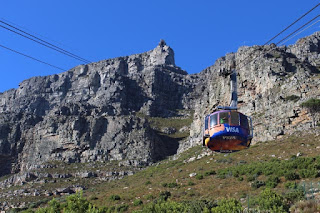 |
| At viewpoint beside the road |
The road south passed through some more spectacular scenery before leaving the hills and entering the flatter, sandier part of the desert.
 |
| Lots of sand... |
The Namib Nauklauf desert has some of the largest sand dunes in the world. The gate into the National Park is at the settlement of Sesreim, consisting of the NP facilities, including a campsite, an upmarket lodge and a campsite/petrol station/convenience store complex. We stayed at this campsite which provided individual shower, toilet facilities and braai facilities for each for each pitch.
 |
| ...and more sand |
 |
| Dune 45 |
The dunes are numbered by their distance from the national park entrance. Dune 45, about 47 km from the entrance has a parking site and is the one that is most climbed. Presumably by providing the parking the park authorities seek to limit the environmental impact of uncontrolled climbing of many dunes.
 |
| The path up Dune 45 |
Climbing a large sand dune is not easy. The last time we did it was in the Sahara in the late 70s when the attraction for our children was to slide down. Going up the sand ridge involves taking a stride up and losing half or more of the height gained as the sand on which you have planted your foot slides back. Walking in someone else's footprints helps as the sand is more compacted ("Mark my footsteps good…").
 |
| A bit further to go |
We decided that the view from halfway up was good enough.
 |
| Lizard - look carefully! |
Apart from the tourists the environment seems to support small lizards. When they stop running they lift their tails and stand on their front legs - presumably to minimise contact with the hot sand.
 |
| Going down is easier |
On the descent we saw that someone had decided to take the short way down rather than follow the path on the ridge – he got seriously bogged down in very fine. loose sand.
 |
| The windward side is reasonably firm - the other side is very soft |
 |
| Dead Vlei |
The paved road through the dune area leads to a dry pan – Sossusvlei, but there is a parking area some distance before reading it where commercial tours are supposed to park their vehicles before visitors gat a shuttle vehicle to the pan. The guide book says that many visitors walk the last part and take the shuttle back, so that is what we decided to do. After a couple of hundred metres, just as we were considering whether this was a good idea, one of the shuttle vehicles stopped and we got on.
The shuttle dropped us at the side of the road and pointed out the path to Dead Vlei – as its name suggest this is a very dry pan where most of the vegetation has died. The driver arranged to pick us up in an hour and a quarter. Having got to the Vlei, we were back in 45 minutes and had to prove to the driver, by a photo, that we'd actually seen it!
 |
| Sossusvlei |
Sossusvlei itself, although also dry, had more vegetation and wildlife.












































 The road to one of the viewpoints has a sign "4WD ?".While we reckon it could have been reached in a 2WD vehicle, we were glad we had a 4WD!
The road to one of the viewpoints has a sign "4WD ?".While we reckon it could have been reached in a 2WD vehicle, we were glad we had a 4WD!










